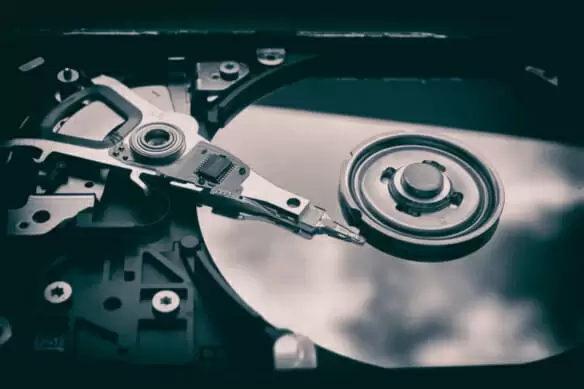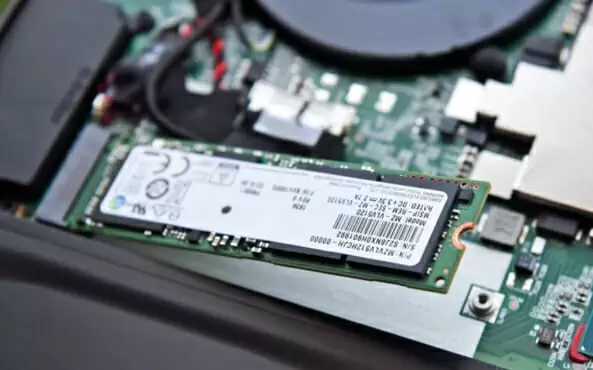eMMC-type storage is commonly found in budget smartphones and cheaper laptops, usually in 32 or 64GB variants.
Its presence on cheaper devices might make you think that it’s not that great of a memory type, but is that actually the case?
In this article we’ll tell you all about eMMC and how it compares to SSD.
What Exactly is eMMC?
eMMC stands for “embedded Multi Media Controller”. MMC storage, or MultiMediaCard, (without the embedded part) was the precursor of SD storage, and since the advent of eMMC has become a rare sight.
eMMC consists in a package of flash memory and a flash memory controller, which is built-in the silicon die. Ergo, eMMC is built by three components: the flash memory, the flash memory controller and the MultiMediaCard interface.
Not too long ago, flash memory was controlled by an application’s CPU.
The CPU managed the writing and reading of data in a myriad of devices. But technology has evolved.
Semiconductors now allow a huge storage density, and have made it inefficient for something else other than something within the flash die to control the memory.
For that reason, eMMC was developed as the standard for flash memory with a bundled controller within the flash die.
A simpler way to put it would be to consider eMMC has a MMC drive embedded on a motherboard.
Where is eMMC Used?
eMMC is mainly used in devices that require a flash drive instead of a mechanical drive, but which price point (and intended usage) doesn’t benefit from having an SSD.
You can find eMMC in cheap laptops and netbooks, budget smartphones and cheaper digital cameras.
How Fast is eMMC?
Currently, eMMC can transfer data at a speed of up to 400MB/s. If you’re aware of SSD SATA data transferring speeds then you might be surprised that they appear to be quite similar. In fact, they both top out at around 400MB/s. Okay, then what’s the catch?
The catch is that a device’s performance isn’t determined exclusively by its data transfer speed. The volume they’re capable of transferring at a given time is also very import. eMMC has fewer memory gates than an SSD, which means it isn’t capable of transferring as much data as an SSD at the same speed.
Even if you don’t care about volume and are only interested in data transferring speeds, an eMMC shouldn’t be on your to-buy list. Even though they’re cheaper than SSDs and have similar data transferring speeds, that only happens when you have a SATA SSD — PCIe SSDs can have a read speed of up to 3,500MB/s (writing is usually slower, topping up at around 2,100MB/s).
What Size Does The Typical eMMC Storage Has?
One thing to note is that eMMC usually works best with smaller file sizes. Therefor, it doesn’t make much sense to have gigantic eMMC drives.
If you’ve ever looked at budget laptops, you’ve probably noticed that their storage usually tops at around 64 GB — that’s the usual “big” eMMC storage size, even though you may sometimes find 128 GB eMMC drives.
If you’re someone who works with large files, an eMMC just won’t cut it — and not only due to its limited storage size. eMMC takes its time with large files — if it can store them at all.
These days, 64 GB just won’t cut it. You’ll soon have to make hard decisions about what to delete or what to uninstall — or resort to cloud services, which will take its toll on your budget.
Is eMMC Storage Something To Avoid?
Short answer — if you’re able to, then by all means avoid it. That’s not to say that there isn’t a market for eMMC. Budget notebooks have it for a reason. It’s relatively fast and cheap, and it will probably last as long as your average SSD.
If you just need a cheap device to watch Netflix and other light usage, such as web browsing and checking emails, than an eMMC storage will work just fine. If, however, you’re handling large, heavy files, you might want to look at something else.
Of course that it’s also worth noting that only cheaper devices have eMMC storage. That means that if you’re looking for something to edit videos, gaming, or any other type of intensive usage, a device with eMMC would never be an option.
Conclusion
As you can see, eMMC is not something to dismiss entirely. It has its uses, and for light tasks it’s way better than a physical hard drive. Even though you should aim for an SSD, if your use-case does not justify it, then there’s no harm in going with an eMMC device.
Just remember that trying to save money when it comes to stuff such as storage, will only result in headaches down the road. You will probably be forced to upgrade your storage or choose which files you want to keep the most.
Do you have any other doubts regarding eMMC? If so, let us know in the comments below.

Petr is a serial tech entrepreneur and the CEO of Apro Software, a machine learning company. Whenever he’s not blogging about technology for itechgyan.com or softwarebattle.com, Petr enjoys playing sports and going to the movies. He’s also deeply interested about mediation, Buddhism and biohacking.


